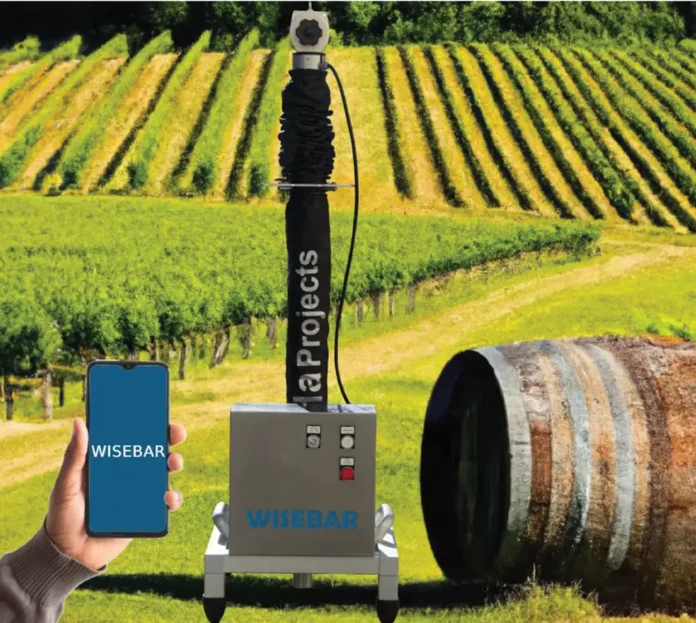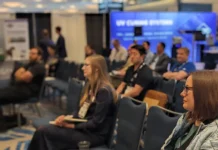By Liz Stevens, writer, UV Solutions
In winemaking, wine barrels are used during the aging process. There are stainless steel barrels, concrete barrels and even clay barrels, but the oak barrels used for red wine and Chardonnay probably are the best known. Aging in oak allows some oxygen to reach the wine and the wood imparts distinctive characteristics to the taste; some wine enthusiasts especially enjoy an “oaky” wine.
Sulfites, compounds that contain the sulfite ion (SO32-) are produced naturally in wine during the fermentation stage. Wineries also commonly add additional sulfites for their preservative value. But sulfites can encourage bacterial growth in wines, leading to an unpleasant vinegar aroma or other taste-affecting defects. And studies have shown that sulfites can be an allergen and may cause headaches and other health issues. In Europe, the wine sector is seeing increased regulation to limit the presence of sulfites in wine.
Oak wine barrels can be reused a few times before the wood’s unique character-building power has been depleted. Sanitizing wine barrels, then, is an important step to allow the reuse of the barrels, but the sanitization must be carefully managed so that the disinfection is performed without altering the wood’s prized qualities or introducing new chemistries that will affect the wine.
Oak barrels can be disinfected by a variety of means, including by lengthy steam treatment – a water- and energy-intensive method; by time-consuming ozone sanitization – in combination with lots of hot water; by ultrasound; by barrel shaving and by other treatments. Ironically, sanitization by use of gaseous SO2 is an efficient treatment but it, of course, only adds to the sulfite presence in the wines. The combination of a short hot water treatment and a relatively short UVC exposure can be effective for disinfecting wine barrels with minimal water and energy use – and without the need for sulfites. E.Vila Projects & Supplies, Barcelona, Spain, has pioneered the use of pressurized hot water plus UVC exposure as an effective means to achieve disinfection.
E.Vila has a technical team with experience in infrared, ultraviolet, UV LED and quartz material solutions. The company serves sectors including aeronautics, the graphics industry, automotive, the wood sector, plastics, labeling, hospital and glass, among many others. The project to develop a UVC sanitization solution for oak wine barrels was led by E.Vila’s Eugenia Vila Vilaró, general director, and José Luis Molina, partner and representative, with a validating study conducted by the Department of Biochemistry and Biotechnology of the Rovira I Virgili University, Tarragona and Reus, Spain. The company developed Wisebar, its patented UVC equipment, in cooperation with Araipiasa Aramatics, Barcelona, Spain, a maker of wine cellar automation solutions.
E.Vila’s method involves treating barrels with pressurized hot water for one minute, followed by five minutes of direct exposure to UVC. This method minimizes the water used and the energy required to heat the water, dramatically cuts the time required for sanitization, and eliminates the need for sulfites or other chemicals for disinfection. The equipment is available in two versions – manual (adjustable) and automatic (pre-programmed for a winery) – and is available for rental or for purchase. The Wisebar system has a connection and HACCP control software via smartphone, computer or tablet.
To produce this equipment, E.Vila designed a special high-power UV amalgam lamp that allows for disinfection in less time, has a longer useful life and is tailored to the geometry of wine barrels. The biggest challenges of this project were in designing a UV emitter to deliver the maximum power in the length necessary to treat the depth of wine barrels, and in finding a university with the necessary experience and knowledge to validate the equipment and technology.
Wine barrels, which are constructed from individual staves of oak, can be disinfected without disassembly. One of the other challenges in the project was to design a UVC lamp to achieve maximum penetration into the porous oak to the same depth or greater depth than other disinfection processes. To facilitate this, the first phase of disinfection – a pressurized hot water wash for one minute – opens the wood’s pores, allowing the UVC energy to penetrate more deeply into the wood.
E.Vila asserts that its method and the Wisebar equipment extend the useful life of oak wine barrels since the wood is not subjected to a lengthy steam or hot water process, to physical alteration or to the chemicals used with other disinfection methods.
Through the use of a method comprised of minimal hot water treatment and UVC exposure, E.Vila delivers a solution that saves money, saves resources and saves time, while protecting public health from allergens introduced by sulfite-oriented sanitization.
For more info, see www.evilaprojects.com.






